Ride Midtown, Capitol Hill, Navy Yard, & Southwest Waterfront Neighborhoods! – eWheel Going Out Group
.
< Click here to go back to RSVP page
*** It’s a great day for an ewheel ride. See you there! ***
UPDATE #2: The email with my cell no. has been sent to the yes RSVPs. TEXT me if you need to. If you do not see my email, check your spam folder, and also make sure your email and Meetup settings allow for you to always receive messages from the organizer. If it’s not there, send me a message through my Meetup profile with YOUR CELL NO. so I can text you back. See you there!
UPDATE #1: I had the incorrect link to the full event description. Link has been updated!
—
Let’s get together for our next ride!

New riders, come join us for the first time! Riders from previous Meetups (Aian Neil, Anibal, Ben, Bob, Brandon, Chris, Connor, Dave, Edwin, Erwin, Haitao, Heather, James, Jeff, Jeremy, Jessica, Joe, John, Jonathan, Kevin, Kris, LeRoy, Loren, Lutalo, Mark, Megan, Melissa, Michael, Nick, Phil, Rakesh, Raul, Richard, Robert, Rodney, Shelly, and Steven), come join us again!
We’ll ride through Midtown, Capitol Hill, Navy Yard, and Southwest Waterfront neighborhoods and stop numerous times along the way to enjoy the sites, memorials, landmarks, and to also let some of the slower riders catch up (if some of us decide to go at a quicker speed). Ideally, we will all ride together and at the same speed, but that may or may not be possible with other pedestrians, bicyclists, cars, etc. sharing the same paths, but let’s do our best please. If there are any riders with short-range wheels, we’ll make a charging stop halfway through the ride at Starbucks in Capitol Hill. In total, it’s a 9.7 mile trip that’s sure to be enjoyable!

We’ll meet up at Washington Circle (in the center) at 2pm. Then we’ll ride north on 23rd Street NW for 0.1 mile, at 2:30pm. Once we come across L Street NW, we’ll make a right and ride east for 1.2 miles.
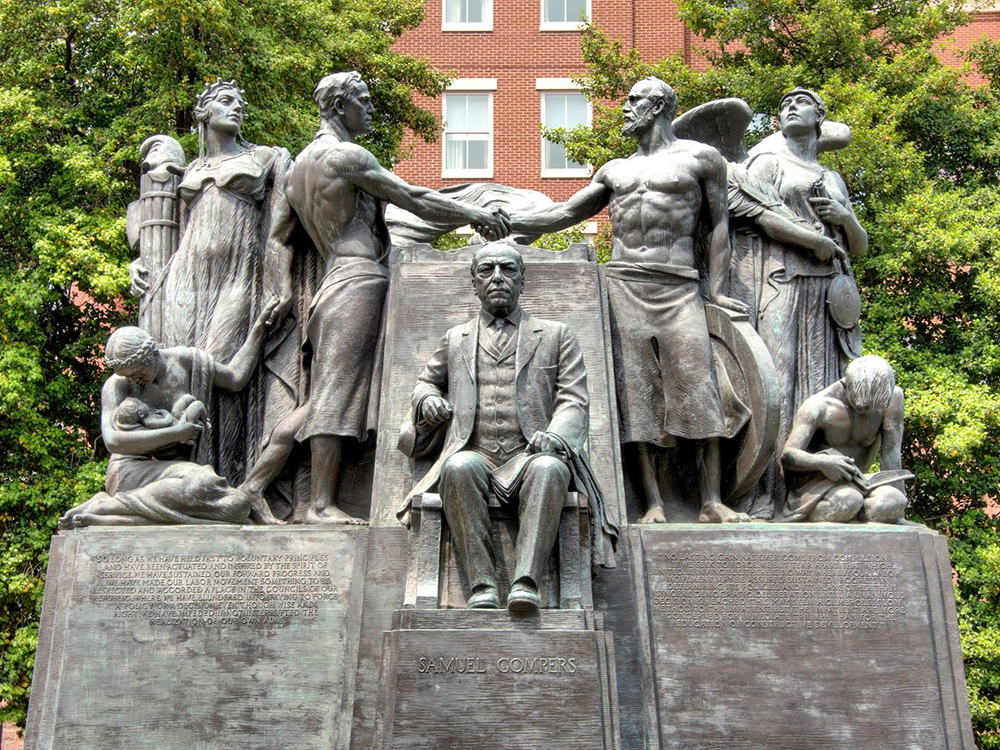
We’ll then arrive at Samuel Gompers Memorial Park (intersection of 11th Street NW). The Samuel Gompers Memorial Park is a small municipal park located near Mount Vernon Square. It’s main claim to fame is the presence of the Samuel Gompers Memorial statue. Gompers, born in London in 1850, was a major figure in the American labor movement, organizing and serving as president of the American Federation of Labor, which later merged with the Congress of Industrial Organizations to form the AFL-CIO. At the AFL, Gompers mainly focused on legislation directly involved with working, such as eight hour days. His large monument features an about twice life size Gompers, dressed in modern clothes and sitting in a chair. The bronze sculpture is on a tall granite base, and he’s surrounded by allegorical figures reading and shaking hands, who symbolize education, justice, cooperation and unity. There’s also a steam engine included in the sculpture symbolizing industry, and the base has inscriptions from Gompers’ speeches.

From there, we’ll turn left on 11th Street NW heading north, then make an immediate right back onto L Street NW, and then travel east 0.4 miles.
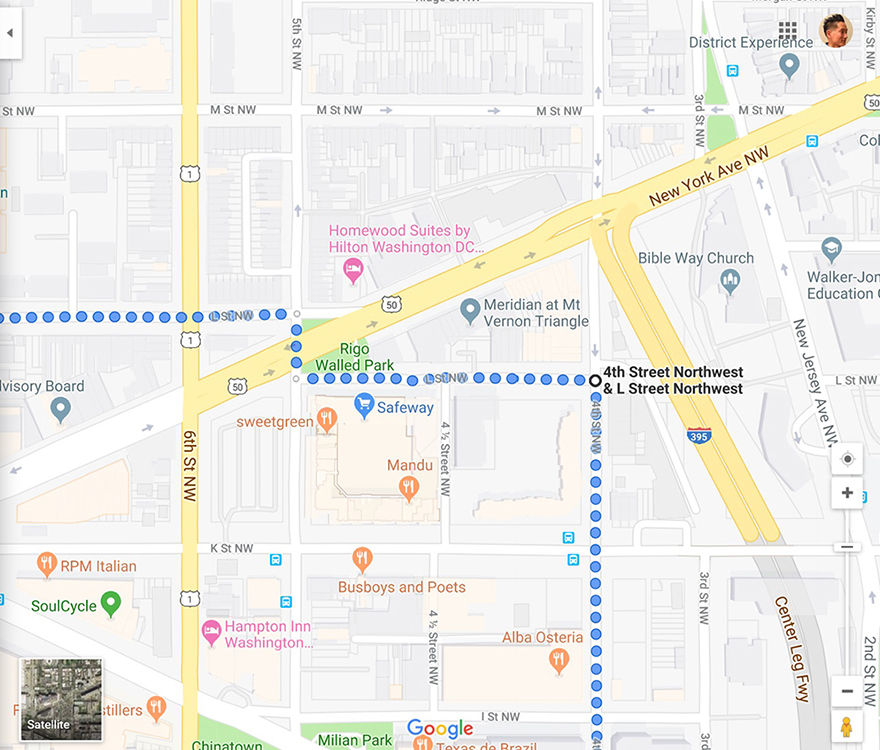
We’ll turn right on 5th Street NW heading south, then make an immediate left back onto L Street NW. We’ll then ride east 0.1 miles to 4th Street NW, where we’ll make a right and ride south another 0.2 miles.

(Left on Massachusetts Ave NW)
We’ll turn left on Massachusetts Ave NW heading southeast, then make an immediate right onto 3rd Street NW, and then ride south 0.8 miles.

Along the way, we’ll come across Union Square (on the left), an 11-acre public plaza at the foot of Capitol Hill. It encompasses the Ulysses S. Grant Memorial (1924) and the 6-acre Capitol Reflecting Pool (1971) and is just west of the United States Capitol building. Views differ as to whether the Square is just east of the National Mall or is itself the eastern end. Interstate 395 transits the Third Street Tunnel just beneath Union Square. The George Gordon Meade Memorial (1927) formerly stood in the northwest section of Union Square; that memorial now stands near the intersection of Constitution Avenue and Pennsylvania Avenue NW.
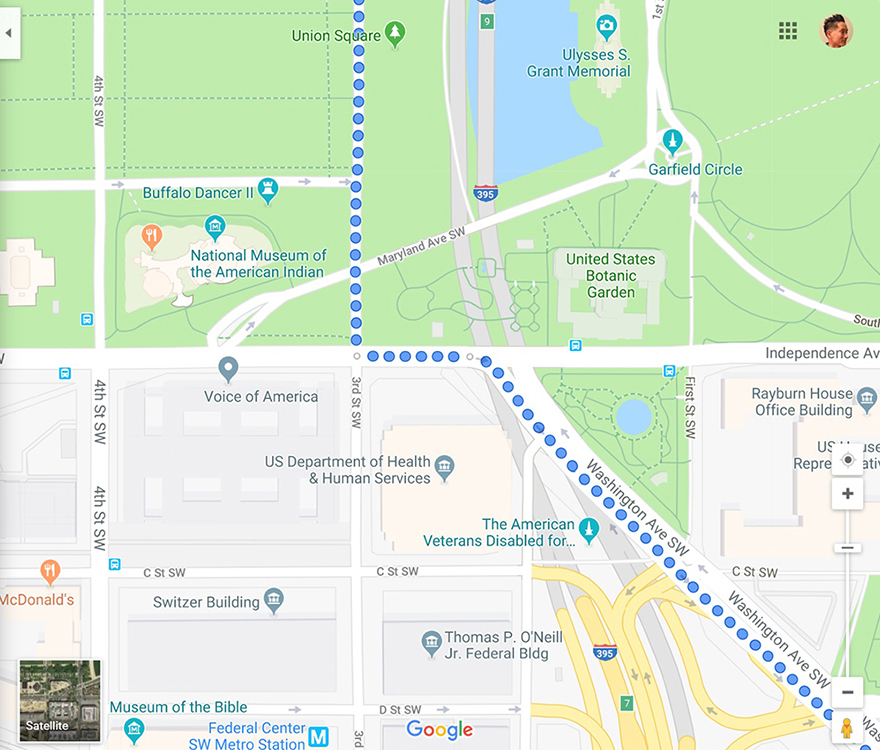
From Union Square, after a couple of blocks heading south, we’ll turn left on Independence Ave SW heading east. Then we’ll make an immediate right onto Washington Ave SW, and ride southeast it for 0.4 miles.

A block after we turn onto Washington Ave SW, we’ll come across Bartholdi Park (on the left). Bartholdi Park is a public park named after French sculptor Frédéric Auguste Bartholdi, who is known primarily for designing the Statue of Liberty. Bartholdi Park is part of the United States Botanic Garden located on the grounds of the United States Capitol. The centerpiece of the park, the Bartholdi fountain, was originally purchased by the United States government for $6,000 in 1877. Previously, the fountain had stood at Fairmount Park during the 1876 Centennial Exposition in Philadelphia. In 2008 the fountain was temporarily removed from the park by the Architect of the Capitol for a complete restoration to repair deterioration of the cast iron and bronze coating, add modern pumps and motors, and install a new water treatment and filtration system. The fountain was returned to the park in spring of 2011. The fountain is 30 feet tall and weighs 30 tons and features three 11 feet tall nymphs holding the upper basin. Other decorations include turtles, cherubs, frogs, fish, as well as twelve electric lamps.

Across the street is the American Veterans Disabled for Life Memorial, a memorial which honors veterans of the armed forces of the United States who were permanently disabled during the course of their national service. The memorial was dedicated by President Barack Obama on October 5, 2014. The memorial consists of 5 elements: (1) The first element is a fountain in the shape of a five-pointed star. In the center of the fountain is an eternal flame. (2) The second element is a reflecting pool. The memorial is designed so the water in both the fountain and the reflecting pool reflect the nearby U.S. Capitol building. (3) The third element is a “Wall of Gratitude”, which consists of two long, 12-foot walls. On the northern segment are quotations from General George Washington and General Dwight Eisenhower, and the name of the memorial. Quotations expressing gratitude for the sacrifices of disabled veterans are inscribed on the southern segment of the wall. A passage between the two segments is cut so that it orients visitors toward the Capitol dome. (4) The fourth element is the “Voices of Veterans” area. This exhibit consists of three staggered glass walls consisting of a total of 49 panels. On the interior sheets of glass are inscribed photo-realistic images of veterans and quotations from veterans describing their devotion to duty, what it was like to be wounded, and how they came to terms with their disability. The four bronze panels feature a saluting soldier in full dress uniform, a soldier rescuing a wounded comrade (who is slung over his shoulders), a running soldier bowed beneath a full pack, and a soldier with an amputated leg using crutches to hold himself upright. (5) The fifth element consists of a grove of memorial trees. The “Voices of Veterans” element is set among the trees of the northern part of this grove. A pedestrian walkway passes through the grove south of the “Voices of Veterans”, to give local workers a means of passing through the site.

We’ll continue on Washington Ave SW, and next, we’ll turn left on E Street SE and ride for 0.2 miles east.

When we arrive at 1st Street SE, we’ll turn right, travel south 2 blocks, and then turn left on F Street SE.

Immediately, this will take us to Garfield Park (on the right). Garfield Park has special historical status within the District as one of the 17 original federal appropriations purchased by the government in 1792 and described by location and function in a note accompanying Andrew Ellicott’s engraving of the L’Enfant plan. Originally identified by L’Enfant as a site for a grand cascade, this land – Original Appropriation No. 17 (Reservation 17) – was improved and transformed into a public park in the late nineteenth century and named Garfield Park. For over two centuries – despite various threats and encroachments over the years by both public and private interests – the land has remained an open public space. The historic residential neighborhood surrounding the park is significant as part of the Capitol Hill Historic District, which has been listed in the National Register of Historic Places since 1976. This park is perfect for your kid who is part spider monkey. The multiple ropes courses, castles that must be accessed by rope bridges and jungle gyms are climber nirvana. The big group swing is great fun and a super ice breaker for the kids to make new friends. The park has great shade, sand volleyball courts (one of the few in the City), tennis and bocce courts and a dog park, too.

From Garfield Park, we’ll get back on F Street SE, which will turn into South Carolina Ave SE. We’ll ride northeast for 0.2 miles

One we arrive at 4th Street SE, we’ll turn right onto E Street SE.

Immediately after turning right onto E Street SE, we’ll arrive at Marion Park (on the left). Marion Park is a public park named after Revolutionary War leader Francis Marion, also known as The Swamp Fox. It is located in the Capitol Hill neighborhood. Locally, it is known informally as Turtle Park because of the large cement turtle in its playground. Marion Park was first established as open ground, dating back to the original plans for the city created by Pierre L’Enfant in 1791. It is one of the larger parks in the Capitol Hill area. A statue to Francis Marion was authorized on May 8, 2008. However it was met with opposition by some local residents. It was argued that they were not consulted by the federal government on the placement of the statue in a DC park. In addition the figure of Francis Marion is controversial as he fought Native Americans and was a slave owner. The park has a playground, and is a popular place to bring dogs. With its interesting walkways and beautiful vegetation, it’s the perfect place to take the kids for a stroll to the playground, or enjoy a snack in the grass under any of many ornamental trees.

From Marion Park, we’ll get back on E Street SE and ride east for 0.5 miles. We’ll then make a right on Pennsylvania Ave SE heading southeast, and then make another immediate right onto 11th Street SE and ride south for 0.4 miles. If there are any riders with short range devices, we can stop at Starbucks for a charging stop, which is north of E Street SE on 8th Street SE. We will have ridden 5 miles at this point, exactly the halfway point of the ride. Otherwise, if no one has a short-range device, we’ll continue on (unless the group wishes to make a stop).

We’ll make a right onto M Street SE and ride west for 1.5 miles.

Along the way, we’ll come across The Bullpen (on the left at the intersection of Half Street SE). Now in its tenth season, The Bullpen remains the original home base for Nationals fans. Voted the best outdoor venue by Washington City Paper, its prime location, only steps outside of Nats Park in Navy Yard, makes it the most sought-after attraction for thousands of fans before, during, and after home games and special events. With live music, cold beers, food trucks, and free admission, The Bullpen is the best place to pregame and unwind for both baseball fans and locals alike. It’s also home to Truckeroo, the award-winning food truck festival that brings together the city’s best food on wheels. Toast to the love of the game at The Bullpen, DC’s largest and most beloved outdoor venue.

We’ll continue west on M Street SW and it will turn into Maine Avenue SW. We’ll travel northwest for 1 mile.
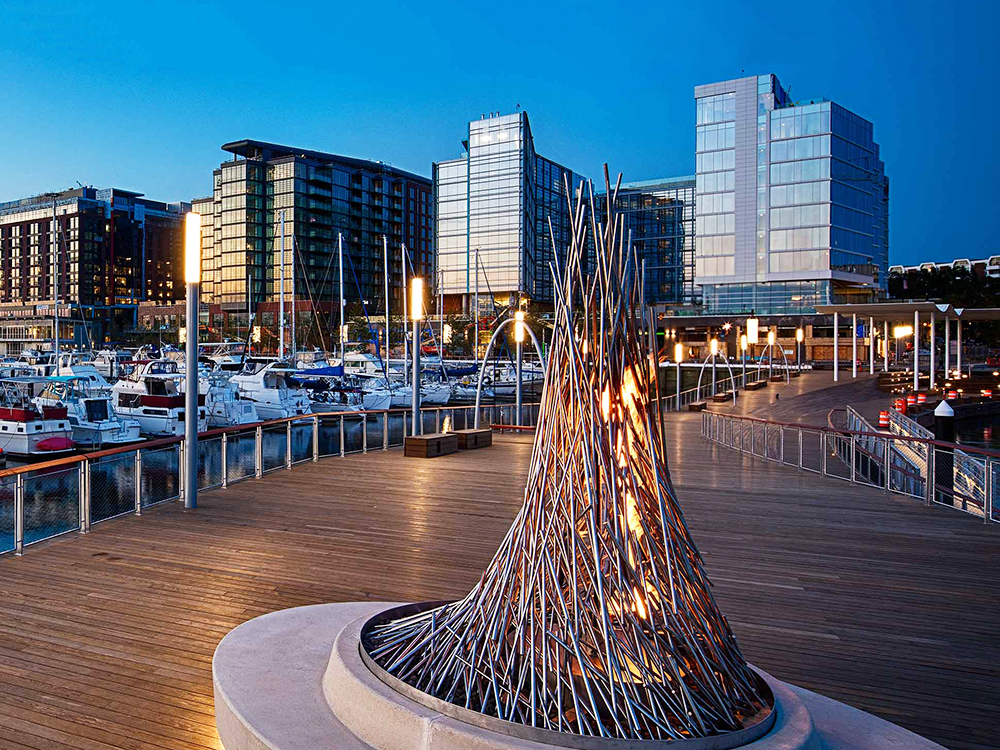
Once we’re on Maine Avenue SW, we’ll shortly come across the Southwest Waterfront. The Southwest Waterfront is one of the most historic areas in the city. It’s home to the nation’s longest continually operating open-air fish market, houseboats and a vibrant riverfront community offering panoramic views, ample recreational activities and easy access to DC’s most beloved monuments and memorials. At the same time, it’s also poised to become one of DC’s hottest neighborhoods with The Wharf, a remarkable, mile-long stretch along the Potomac River that comes to life with restaurants, retailers, residences, and businesses, the first phase of of which is complete. The Southwest Waterfront is also home to the east coast’s largest population of “liveaboards,” or people who domicile on boats year-round. Many are docked at Gangplank Marina, side-by-side with DC cruise boats. In warm weather, expect to catch free outdoor movies, yoga and other workout programs here. In cold weather, during the holidays, the waterfront attracts a procession of brightly illuminated boats, as part of the Parade of Lighted Boats, which begins in Old Town Alexandria. The Maine Avenue Fish Market is one of the few surviving open air seafood markets on the east coast, a local landmark, and the oldest continuously operating fish market in the United States, 17 years older than New York City’s Fulton Fish Market.

Along the way, we’ll come across Benjamin Banneker Park (on the right at the intersection of 9th Street SW). Benjamin Banneker was an African American astronomer and almanac author. In 1791, Banneker assisted in the initial survey of the boundaries of DC. This 4.7 acres urban park features a prominent overlook at the south end of L’Enfant Promenade. The park is stop number 8 on Washington’s Southwest Heritage Trail. The elliptical 200 feet wide overlook provides elevated views of the nearby Southwest Waterfront, Washington Channel, East Potomac Park, Potomac River and more distant areas. The centerpiece of the overlook’s modernist plaza is a large conical fountain that projects water more than 30 feet in the air and catches it in a circular basin made from honed green granite. The rings of the fountain and basin in the center of the site are reiterated in the benches, double rows of London plane trees, and low concrete walls that establish the plaza’s edge. The ground plane is paved with granite squares, a continuation of L’Enfant Promenade’s materials. The ground plane is concave, and with the trees and fountain helps define the spatial volume of the plaza.

We’ll get back on Maine Ave SW, which will turn into Independence Ave SW, and travel west for 0.8 miles.
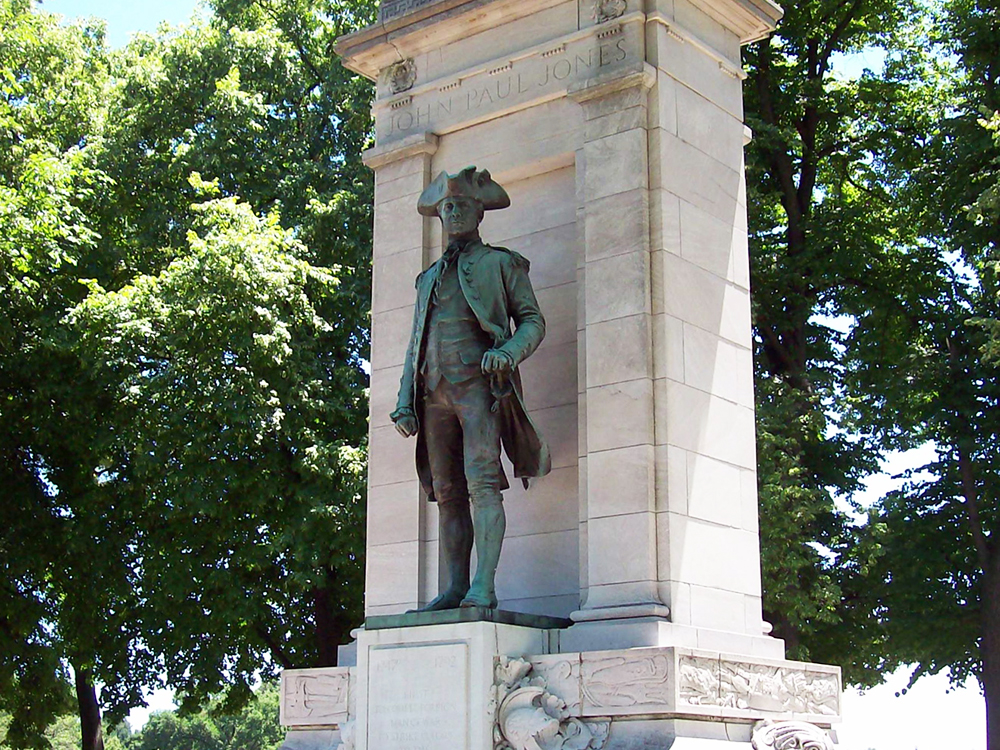
Along the way, we’ll come across John Paul Jones Memorial (on the right at the intersection of 17th Street SW). The memorial honors John Paul Jones, the United States’ first naval war hero, father of the United States Navy, the only naval officer to receive a Congressional Gold Medal during the American Revolutionary War, and whose famous quote “I have not yet begun to fight!” was uttered during the Battle of Flamborough Head. A nearby marker contains a biographical sketch of John Paul Jones, and describes the memorial’s history and features. The memorial consists of a 10-foot bronze statue and a 15-foot marble pylon. On each side of the monument, water flows out of ducts into a small pool. On the reverse side of the monument is a bas-relief of Jones raising the United States flag on his ship, the Bonhomme Richard. The event is believed to be the first time the United States flag was flown on an American warship. The statue is listed on the National Register of Historic Places as part of the American Revolution Statuary group in DC.

Next, we’ll continue west on Independence Ave SW, and shortly come across the DC War Memorial (on the right at the intersection of Homefront Drive SW). The DC War Memorial commemorates the citizens of DC who served in World War I. It was the first war memorial to be erected in West Potomac Park, and remains the only local District memorial on the National Mall. It is in the form of a 47-foot tall circular, domed, peristyle Doric temple. Resting on concrete foundations, the 4 foot high marble base defines a platform, 43 feet in diameter, intended for use as a bandstand. Preserved in the cornerstone of the DC World War Memorial is a list of 26,000 Washingtonians who served in the Great War. Inscribed on the base are the names of the 499 District of Columbia citizens who lost their lives in the war, together with medallions representing the branches of the armed forces. In September 2008, with the support of Frank Buckles, then the last living US veteran of World War I, proposed a bill in Congress stating the memorial should be expanded and designated the national memorial to World War I. In July 2010, the National Park Service announced that restoration work, funded by the American Recovery and Reinvestment Act of 2009, would soon begin on the memorial. Work began in October 2010, and the memorial reopened on November 10, 2011.

We’ll continue west on Independence Ave SW until we reach 23rd Street SW, where we’ll make a right and ride for 1.2 miles.

Shortly after we turn onto 23rd Street SW (on the left), we’ll come across the Lincoln Memorial. The Lincoln Memorial is an American national memorial built to honor the 16th President of the United States, Abraham Lincoln. Dedicated in May 1922, it is one of several memorials built to honor an American president. It has always been a major tourist attraction and since the 1930s has been a symbolic center focused on race relations. The building is in the form of a Greek Doric temple and contains a large seated sculpture of Abraham Lincoln and inscriptions of two well-known speeches by Lincoln, The Gettysburg Address and his second inaugural address. The memorial has been the site of many famous speeches, including Martin Luther King Jr.’s “I Have a Dream” speech, delivered on August 28, 1963, during the rally at the end of the March on Washington for Jobs and Freedom. It is open to the public 24 hours a day. In 2007, it was ranked seventh on the List of America’s Favorite Architecture by the American Institute of Architects.
Directly in front of the Lincoln Memorial is the Reflecting Pool, the largest of the many reflecting pools in DC. Part of the iconic image of Washington, the reflecting pool hosts many of the 24 million visitors a year who visit the National Mall. It is lined by walking paths and shade trees on both sides. Depending on the viewer’s vantage point, it dramatically reflects the Washington Monument, the Lincoln Memorial, the Mall’s trees, and / or the expansive sky. It is approximately 2,029 feet long (over a third of a mile) and 167 feet wide. It has a depth of approximately 18 inches on the sides and 30 inches in the center. It holds approximately 6,750,000 U.S. gallons of water. Using funding from the American Recovery and Reinvestment Act of 2009, the National Park Service reconstructed the Lincoln Memorial Reflecting Pool. The pool’s water supply system was updated to eliminate stagnant water by circulating water from the Tidal Basin; the pool was formerly filled using potable water from the city. Paved walking paths were added to the north and south sides of the pool to replace worn grass and to prevent further erosion.
We’ll continue on 23rd Street SW until we return back to Washington Circle.
Come join us as we spend an afternoon together exploring the sites, memorials, and landmarks Midtown, Capitol Hill, Navy Yard, and Southwest Waterfront have to offer! Please also help spread the word of our group and the ride!
I look forward to seeing you there!
– J.T.
—
METRO & PARKING
We’ll meet at Washington Circle. The closest Metro is Foggy Bottom (Orange, Blue, Silver lines). I suggest taking Metro / taxi / ride-share services if you can. I also recommend using wmata.com for travel planning. Don’t forget to account for Metro, traffic, and parking delays. If you are driving, you will need to find street parking or a garage. I recommend using parkopedia.com for garage parking planning.
DRESS
Please dress appropriately for the weather. For those with problems having their feet go numb or tired during long rides, I recommend wearing shoes with a stiff and flat sole.
RIDING ETIQUETTE / RULES
Since e-wheels are relatively new technology, please be as courteous as possible to other pedestrians, bicyclists, etc. Based on personal experience (I’ve been riding daily since 2015), I’ve noticed some general good practices and rules to follow. 1) ALWAYS give pedestrians the right of way. 2) When riding on a narrow sidewalk, and you’re coming up behind a pedestrian and you need to pass them, either a) wait until there’s an opening, or b) clear your throat and say “excuse me” or “on your left” in a *gentle* manner (I’ve noticed people tend to get startled / surprised when they see and hear a tall figure behind them on a wheel) before passing them. 3) SLOW DOWN to a pedestrian’s walking pace (until you are completely clear of them) whenever approaching or passing (whichever direction they are walking). Only after passing a pedestrian for a little distance is it a good idea to go faster than walking pace. Whatever you do, please do NOT wiz by them. 4) Thank the pedestrian as you are passing. 5) Slow down as you are going around a turn (whether there are other pedestrians in sight or not) with a lot of bushes or other obstacles next to the sidewalk, as they can be coming from the other end of the turn (and not be visible initially). 6) Ride single file whenever pedestrians are around (on the sidewalk), or cars are around (in the bike lane) 7) Dismount when in the official memorial areas, such as the FDR Memorial (it’s the law)
RIDING SKILL
For the safety of others and ourselves, we will all be required to be able to perform all of the following: (1) comfortably balance on the wheel while riding straight and turning left or right (2) ride at a snail’s pace and (3) start and stop comfortably without the need to hold onto any wall, post, or similar structure.
LEGALITY
People have asked me questions regarding the laws pertaining to riding our e-wheels in the DC metro area. I did a lot of research before purchasing my e-wheel to ensure I could make use of it. In short, they are considered Personal Mobility Devices or Electric Personal Assistive Mobility Device. (1) Virginia: “An electric personal assistive mobility device or motorized skateboard or foot-scooter may be operated on any highway with a maximum speed limit of twenty-five miles per hour or less. An electric personal assistive mobility device shall only operate on any highway authorized by this section if a sidewalk is not provided along such highway…” See link here. (2) Washington DC: “Personal Mobility Device (“PMD”) means a motorized propulsion device designed to transport one person, OR a self-balancing, two non-tandem wheeled device, designed to transport only one person with an electric propulsion system. Permitted on Sidewalk – Yes, except PMDs are generally not permitted on sidewalk space in the Central Business District. Permitted on Bike Lanes – Yes.” See link here. (3) Maryland: “‘Electric personal assistive mobility device’ or ‘EPAMD’ means a pedestrian device that: (1) has two nontandem wheels; (2) is self-balancing; (3) is powered by an electric propulsion system; (4) has a maximum speed capability of 15 miles per hour; and (5) is designed to transport one person” and “At an intersection, a person using an EPAMD is subject to all traffic control signals, as provided in §§ 21-202 and 21-203 of this title. However, at any other place, a person using an EPAMD has the rights and is subject to the restrictions applicable to pedestrians under this title.” De jure, the law applies to devices with 2 wheels, as the law was written when only Segways existed and electric unicycles, et al. did not. De facto, for practical purposes, and based on our members’ interaction with law enforcement officers thusfar, our devices have been treated as being covered under this statute (they are explicitly covered under DC and Virginia law). See link here and here. “Green” devices for the win!
RAIN
If there’s a greater than a 35% chance of rain, we’ll cancel or reschedule. I’ll post an update to the top of the event posting by 11:30am on the day of the event, and also send an email out to the yes RSVPs.
< Click here to go back to RSVP page
.
